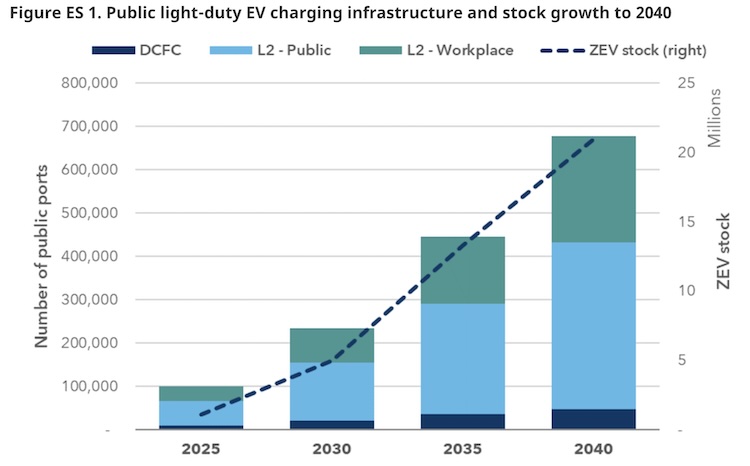Open until Sept. 19, NRCan’s latest Zero Emission Vehicle Infrastructure Program (ZEVIP) RFP for EV charger deployments keeps Canada’s charging network expansion on track while targeting growing pains in the EV charging ecosystem

NRCan has opened a new request for proposals to access ZEVIP funding targeting charging in public and private locations.
The latest NRCan Zero Emission Vehicle Infrastructure Program (ZEVIP) RFP is open until Sept. 19 and targets charging ecosystem growing pains
Earlier this month, the federal government launched a new request for proposals under the Zero Emission Vehicle Infrastructure Program (ZEVIP).
Open for applications until Sept. 19, the RFP will continue the government’s support for deployment of public chargers as well as chargers in private locations, such as multi-unit residential buildings (MURBs) and workplaces.
Since 2019, NRCan says it has provided funding for more than 40,000 EV chargers. The current installed base of public chargers is just under 30,000.
This latest round of funding intends to bring the country closer to reaching the government’s goal of having 84,500 EV chargers (DC Fast and Level 2s combined) deployed across Canada by 2029.
Successful applications may receive up to $5 million per project. ZEVIP will pay a maximum of 50 per cent of total project costs. (Indigenous businesses and communities are eligible to receive up to 75 per cent.)
ZEVIP giving priority to underserved areas
This round of ZEVIP funding also includes a few new wrinkles. These details were first disclosed in a session at Electric Autonomy’s EV & Charging Expo in May featuring Mike Davis, NRCan ZEVIP program manager, and Melissa Chow, director of investments at the Canada Infrastructure Bank.
The most prominent change aims to ensure a significant portion of the new funding goes to putting chargers in underserved areas.
Large gaps in the current charging network, most acute in remote and northern areas, were identified last fall in an audit of the ZEVIP program by the Commissioner of the Environment and Sustainable Development.
In response, NRCan created an EV Public Charging Planning Map with colour codes to classify highways and major roads on a five-point priority scale. Highest priority areas (level 5) are in red while the lowest (level 1) are in dark green.
According the ZEVIP RFP, applications for projects where at least 50 per cent of the proposed charging stations are in level 5 locations may receive priority treatment when NRCan awards funding.
Updated charging needs report
The pace at which Canada’s EV charging infrastructure is growing is another topic that gets even wider scrutiny — particularly from organizations like the Canadian Vehicle Manufacturers’ Association and Global Automakers of Canada.
For some time, automaker lobby groups have cited a lack of chargers in arguments against the federal Electric Vehicle Availability Standard. (The Standard mandates 100 per cent of all new vehicle sales by 2035 be zero-emission. There are interim targets of 20 per cent by 2026 and 60 per cent in 2030.)
Last year, they launched the Road to 35 website to track progress in filling “incentive and charing infrastructure gaps” that, they argue, must be overcome to make the current ZEV sales target reachable.
For its part, the government maintains network growth is keeping pace with rising demand.
To help make its case, in tandem with the new ZEVIP RFP, NRCan released an independent study — the 2024 Charging Needs Report — that lays out forecasted charging needs between 2025 and 2040.

This 2024 report for the government is third in the past six years from Dunsky Energy + Climate. It updates its forecasts for Canada’s light-duty charging needs in its previous 2022 report and also presents, for the first time, expected charging needs for medium- and heavy-duty vehicles by 2040.
Compared to 2022, the new report sets a slightly higher target for the number of chargers (DC Fast and Level 2) Canada needs by 2040. This is based on expected ZEV sales under the current mandate.
In total, it says the country will need 679,000 public charging ports by that date. In the previous report, it the forecast was for 643,000 ports. The gap is much less, however, for 2035, when Dunsky’s new forecast pegs the need at 447,000 public ports. In its 2022 forecast, Dunsky set the 2035 need at 442,000.
Based on the updated forecast, Canada needs, on average, 40,000 more public ports each year between 2025 and 2040.
NRCan says home charging a key variable
These figures come from what the report calls its “baseline” scenario. That scenario also assumes there will be a high volume of home charging installations to complement the public network.
There are different potential scenarios for the amount of home charging that actually gets installed. Much depends on the reach of regulations requiring EV charging in MURBs. Therefore the report includes extensive details on how its predictions change based on other scenarios.
The report forecasts the costs involved in meeting these targeted needs. For the first time, it also examines the potential impact on Canada’s energy grid as the pace of EV adoption and charging demand grows.






